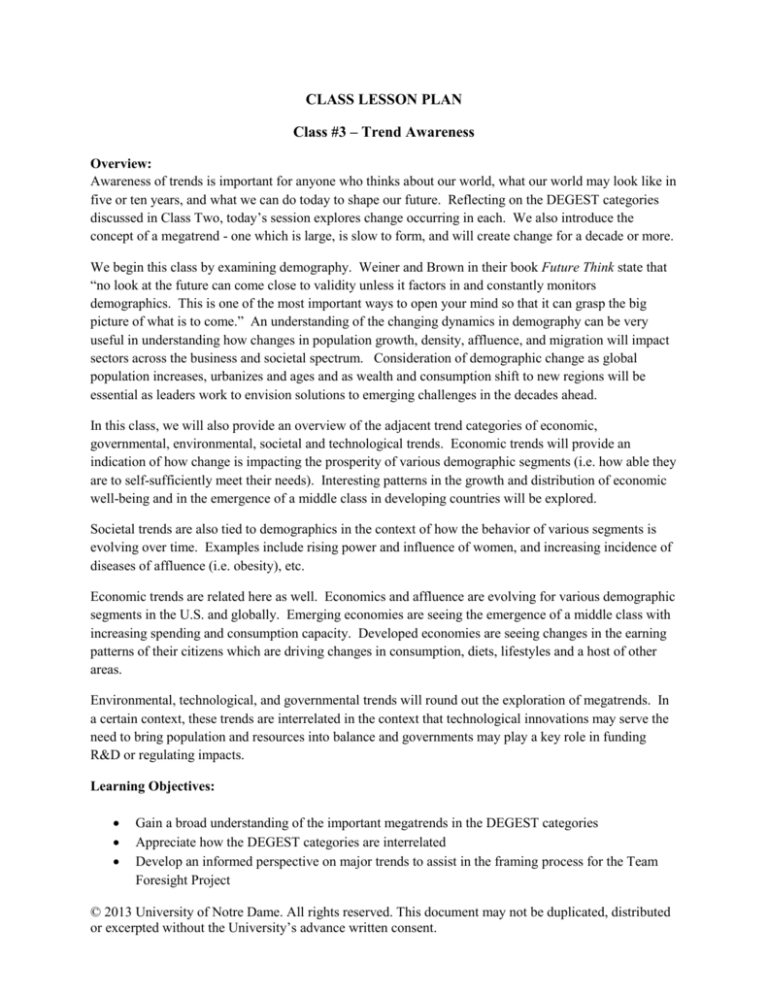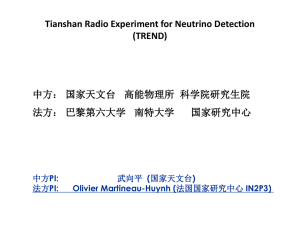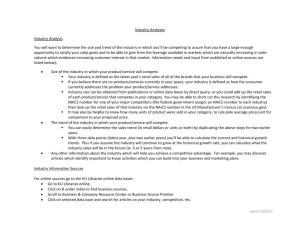
CLASS LESSON PLAN
Class #3 – Trend Awareness
Overview:
Awareness of trends is important for anyone who thinks about our world, what our world may look like in
five or ten years, and what we can do today to shape our future. Reflecting on the DEGEST categories
discussed in Class Two, today’s session explores change occurring in each. We also introduce the
concept of a megatrend - one which is large, is slow to form, and will create change for a decade or more.
We begin this class by examining demography. Weiner and Brown in their book Future Think state that
“no look at the future can come close to validity unless it factors in and constantly monitors
demographics. This is one of the most important ways to open your mind so that it can grasp the big
picture of what is to come.” An understanding of the changing dynamics in demography can be very
useful in understanding how changes in population growth, density, affluence, and migration will impact
sectors across the business and societal spectrum. Consideration of demographic change as global
population increases, urbanizes and ages and as wealth and consumption shift to new regions will be
essential as leaders work to envision solutions to emerging challenges in the decades ahead.
In this class, we will also provide an overview of the adjacent trend categories of economic,
governmental, environmental, societal and technological trends. Economic trends will provide an
indication of how change is impacting the prosperity of various demographic segments (i.e. how able they
are to self-sufficiently meet their needs). Interesting patterns in the growth and distribution of economic
well-being and in the emergence of a middle class in developing countries will be explored.
Societal trends are also tied to demographics in the context of how the behavior of various segments is
evolving over time. Examples include rising power and influence of women, and increasing incidence of
diseases of affluence (i.e. obesity), etc.
Economic trends are related here as well. Economics and affluence are evolving for various demographic
segments in the U.S. and globally. Emerging economies are seeing the emergence of a middle class with
increasing spending and consumption capacity. Developed economies are seeing changes in the earning
patterns of their citizens which are driving changes in consumption, diets, lifestyles and a host of other
areas.
Environmental, technological, and governmental trends will round out the exploration of megatrends. In
a certain context, these trends are interrelated in the context that technological innovations may serve the
need to bring population and resources into balance and governments may play a key role in funding
R&D or regulating impacts.
Learning Objectives:
Gain a broad understanding of the important megatrends in the DEGEST categories
Appreciate how the DEGEST categories are interrelated
Develop an informed perspective on major trends to assist in the framing process for the Team
Foresight Project
© 2013 University of Notre Dame. All rights reserved. This document may not be duplicated, distributed
or excerpted without the University’s advance written consent.
Key Concepts:
Megatrend
Demography
Migration
Population Pyramid
Natural Language Computing
Environmental Economics
Ecological Footprint
DEGEST / STEEP
Fertility and Mortality Rates
Dependency Ratio
Ubiquitous Computing
Augmented Reality
BRICS
Overshoot
Class Preparation:
Readings:
No Readings
1.
2.
3.
4.
Discussion Questions:
As you explored for a trend for your Graph, Photograph, Paragraph assignment, what challenges
did you face in finding evidence of the trend you are considering?
For the trend you considered for your Graph, Photograph, Paragraph, what interrelationships exist
with other trends? How will these interrelationships affect your perspective of the future
implications of the trend?
As we look at megatrends, the impact population growth seems to be pervasive in many of them?
How can the world provide an adequate standard of living for a projected 2.6 billion more people
by 2050 without causing widespread environmental damage?
Understanding interrelationships between trend categories is key for foresight. What is an
example of the relationship of demographics to economics?
Assignment Due:
Graph, Paragraph, Photograph assignment due by ___________________________________.
Be prepared to briefly discuss your observation in Class Three.
© 2013 University of Notre Dame. All rights reserved. This document may not be duplicated, distributed
or excerpted without the University’s advance written consent.
INSTRUCTOR GUIDELINES
Discussion Questions with Answers:
1. As you begin to explore for a trend for your Graph, Photograph, Paragraph assignment, what
challenges do you face in finding evidence of the trend you are considering?
A: Finding evidence that is a good fit with your topic is an important challenge with evidence
gathering. This challenge is addressed through the process of indicator identification. Choosing
an indicator that accurately represents the trend you are assessing is critical. We will get into
indicator identification later as we move into the trend analysis and forecasting module. So for
now, it is important to gain an understanding that the fit of the indicators is important and
sometimes complex.
Another challenge comes when the data you seek is not available. In some cases, it will be
required to work with imperfect or incomplete data or evidence, which makes the challenge of
trend analysis and projection more difficult. When this occurs, taking a more qualitative
approach, often built upon intelligence gathered from experts in the field can help bridge the gap
caused by imperfect or incomplete data.
2. For the trend you considered for your Graph, Photograph, Paragraph, what interrelationships exist
with other trends? How will these interrelationships affect your perspective of the future
implications of the trend?
A: Trends occur within the context of systems, which is to say they interact with the system and
cause unforeseen or unexpected consequences. So the challenge in trying to understand the
impact of a trend, you need to take a systems perspective. Looking across the range of DEGEST
categories is a good first step, and proactively questioning the interaction of the trends is an
important part of the process. We will cover systems assessment later in Module 1, so for now it
is useful to consider the range of DEGEST categories and explore their interactions.
3. As we look at megatrends, the impact population growth seems to be pervasive in many of them?
Can the world provide an adequate standard of living for a projected 2.6 billion more people by
2050 without causing widespread environmental damage? What are the arguments for and
against controlling population growth?
A: Make a case for not controlling the world’s population growth
Technological advances have and will continue to allow humans to overcome
environmental constraints that all species face and increase the earth’s carrying capacity
for humans
Make a case for controlling the world’s population
We are not presently providing basic necessities for about one in every five people—a
total of 1.5 billion people. How can we provide basic necessities for another 2.6 billion
people (a high percentage from developing countries) by 2050?
© 2013 University of Notre Dame. All rights reserved. This document may not be duplicated, distributed
or excerpted without the University’s advance written consent.
Death rates may increase because of declining health and environmental conditions, as is
already happening in Africa.
Environmental degradation will intensify.
4. Understanding interrelationships between trend categories is key for foresight. What is the
relation of demographics to economics?
A: Economics is a social science that deals with the production, distribution and consumption of
goods and services. Demography is the scientific study of human populations including their
size, composition, distribution, density and growth as well as the causes and socioeconomic
consequences of changes in these factors. The answer to the question is somewhat complex. We
could also ask, “what is the relation of economics to sociology?” The original work dates from
Malthus who believed that population would be held in check by famine or lack of resources and
that population growth would subject the lower members of society to distress. For a good
article on the subject and the history of economic demography, dating from Malthus, see
Economic Demography, Andrew Mason, 2003.
Class Timeline:
See PowerPoint and discussion points and questions included therein. An approximate time
breakdown is as follows:
o 50 Minutes – Overview of Megatrends
Demography – 30 minutes
Others – 20 minutes
o 10 Minutes – Implications for Business - Examples
o 10 minutes – Selective discussion of student Graph, Photograph, Paragraph submittals
o 5 minutes – Wrap Up and Prep for Next Class
Classroom Activities/Short Assignments:
This activity not used due to time constraints. Keep in mind for future sessions…
After running through the overview of megatrends, students will organize in groups of 4-5 to
discuss megatrends.
o
First, the groups will be assigned a sector/company and asked to prioritize from the full
list of megatrends those which would be most relevance and impactful for the assigned
sector/company. Have the groups write their priorities on an index card and be prepared
to report out at the end of the session.
o
Second, the groups will be asked to look for interrelationships between the trends. How
does change in one affect the others? Is change in one trend drives change in the others?
Is the relationship direct or inverse? Is there any interaction that is uncertain or
unpredictable?
© 2013 University of Notre Dame. All rights reserved. This document may not be duplicated, distributed
or excerpted without the University’s advance written consent.
o
Keep the perspective of your assigned sector/company, discuss the trends with your
group, and plan to report your perspectives to the class at the end of the session.
o
Allow 10 minutes for group discussion and 10 minutes for report out.
Multimedia and other supplements:
Demographic Divide video (not used)
http://www.youtube.com/watch?v=LygyRoxRzyE
Shift Happens 2011 – Social Media video
http://www.youtube.com/watch?v=e9JJ_Luhvr4
Augmented Reality video
http://www.youtube.com/watch?v=U2uH-jrsSxs
http://www.youtube.com/watch?v=D-A1l4Jn6EY
Supporting readings are:
o Future Think, by Weiner and Brown, Chapter 10, “Demography”
o “Learnings From The Long View, by Peter Schwartz, Global Business Network
o Sustaining the Earth, by Miller and Spoolman, Sections 4-4, 4-5 and 4-6, pp. 78-93
Scan Trends Magazine archive and current trends to identify possible readings for students.
Other Materials:
Excel spreadsheet summary of various demographic data
List of discussion questions and answers
© 2013 University of Notre Dame. All rights reserved. This document may not be duplicated, distributed
or excerpted without the University’s advance written consent.










